Bills, often referred to as beaks, are remarkable adaptations found in numerous animal species. While the terms “beak” and “bill” are sometimes used interchangeably, this article will focus on showcasing animals with bills that go beyond the traditional small and pointy beak. Instead, we will explore creatures with distinguished beaks that are often referred to as bills based on their defining characteristics. Many of these bills are long and strong, large and fleshy, or curiously curved. Some have pouches, while others are hooked. One thing they all have in common is their bills are a huge part of their ability to survive.
In this comprehensive guide, we will organize the list by species, providing examples of subspecies that boast the longest or largest bills. By highlighting these exceptional bill structures, we aim to showcase the diverse adaptations that have evolved in the animal kingdom. So, join us as we embark on a journey through the fascinating world of animals with extraordinary bills that have surpassed a simple beak structure.
1. Albatross:

Waved
albatross
is a bird on the Galapagos Islands.
©Don Mammoser/Shutterstock.com
An albatross is a type of large seabird belonging to the family Diomedeidae. The bill of an albatross is a prominent feature and is adapted for capturing and consuming prey from the ocean surface. The size and shape of the bill can vary among different albatross species. Albatross bills are typically long, strong, and hooked, allowing them to snatch fish, squid, and other prey items from the water.
The color of the bill can also vary, ranging from yellow to pinkish or black, depending on the species. The bill is an important tool for albatrosses in their feeding behaviors and is essential for their survival in the marine environment.
Types of albatrosses with large bills include:
- Grey-headed Albatross
- Northern Royal Albatross
- Southern Royal Albatross
- Wandering Albatross
2. Billfish:
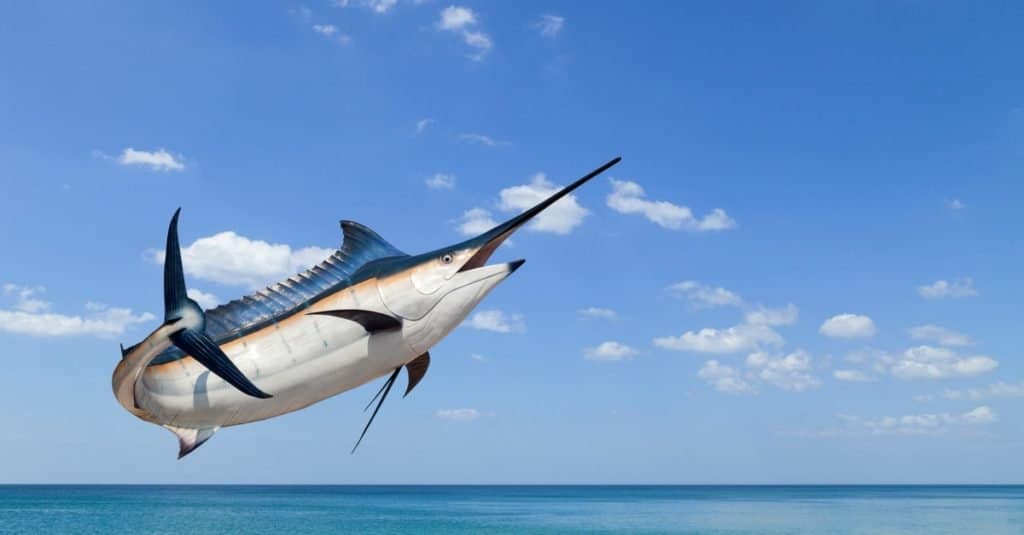
Swordfish are a popular sport fish of the billfish category, though elusive. They are elongated, round-bodied, and large bills.
©Stock High angle view/Shutterstock.com
Billfish are a group of predatory fish species that belong to the taxonomical family Istiophoridae. The bills of billfish are elongated and sharp, resembling a spear or a sword. The bill is used by billfish for various purposes, including hunting, slashing at prey, and stunning their prey. It is an important tool in their feeding strategy. The billfish family includes species such as marlin, sailfish, and swordfish, all of which have distinct bills.
The swordfish (Xiphias gladius) is known to have the longest bill among the billfish species. The bill of a swordfish can be about one-third of its body length and is smooth, flat, pointed, and sharp. Other billfish species, such as marlin, have shorter and rounder bills compared to the swordfish.
3. Curassows:

Curassows have strong bills used for feeding and communication.
©iStock.com/Eduardo Cabrera Abizaid
A curassow is a type of bird belonging to the family Cracidae. Curassows are large, ground-dwelling birds found in the tropical forests of Central and South America. Curassows have strong bills that are often brightly colored. The shape and coloration of the bills can vary among different species of curassows. For example, the male Blue-billed Curassow has a blue cere (the fleshy covering on the upper bill) and wattle, while the female has a knob on her bill. The bills of curassows are used for various purposes, including feeding, communication, and defense.
Examples of Curassows with larger bills include:
- Blue-billed Curassow
- Humboldt’s Curassow
- Wattled Curassow
- Yellow-knobbed Curassow
4. Ducks:

Ducks have big, strong bills used for many things, including catching fish.
©natthawut ngoensanthia/Shutterstock.com
Ducks are a group of species of water birds that are relatively small in size and have shorter necks compared to their close relatives, swans, and geese. The bill of a duck is a specialized structure that is adapted for various functions such as feeding, preening, and communication. Ducks use their bills to catch and filter food from the water, groom their feathers, and make various vocalizations. The shape and size of a duck’s bill can vary depending on the species and their specific feeding habits.
Some ducks with particularly large and fleshy bills include:
- American Black Duck
- Cinnamon Teal
- Common Merganser
- Hooded Merganser
- Northern Shoveler
- Red-breasted Merganser
- Ruddy Duck
5. Flamingos:

Flamingos have big, beautiful bills.
©Ondrej Chvatal/Shutterstock.com
Flamingos are a type of wading bird known for their distinctive pink feathers, long legs, and curved beaks. They belong to the family Phoenicopteridae and are the only extant family in the order Phoenicopteriformes. Flamingos have long, curved bills that are adapted for their feeding behavior. They use their bills to filter food from the water, such as algae and small crustaceans.
The shape and size of a flamingo’s bill can vary among different species, but they are generally long and slender, allowing them to reach into the water and strain out their food.
There are six species of flamingos in the world, and all of them have large bills that are adapted for their feeding behaviors. These include:
- American Flamingo
- Andean Flamingo
- Chilean Flamingo
- Greater Flamingo
- James’s Flamingo
- Lesser Flamingo
6. Frigatebirds:
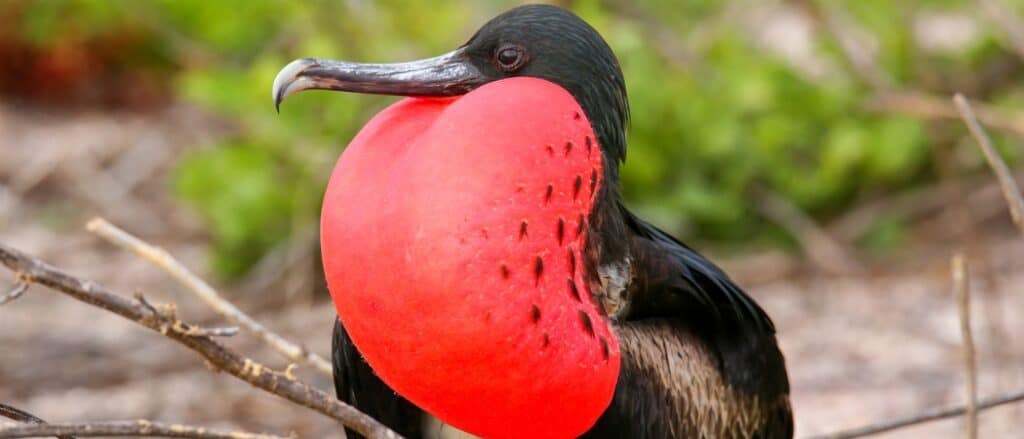
Magnificent
frigatebird
with chest puffed up
©Don Mammoser/Shutterstock.com
A frigatebird is a type of seabird belonging to the family Fregatidae. Frigatebirds have long, slender bills that are hooked at the end. Their bills are adapted for capturing and feeding on fish and other prey items. The shape and size of a frigatebird’s bill can vary among different species, but they are generally long and pointed, allowing them to snatch food from the water’s surface.
Frigatebirds with large bills include:
- Great Frigatebird
- Magnificent Frigatebird
7. Galapagos Finch:
A Galapagos Finch, also known as Darwin’s Finch, refers to a group of small land birds that are native to the Galapagos Islands. In the case of the Galapagos Finch, their bills are adapted to different feeding behaviors and have varying shapes and sizes. Charles Darwin famously studied the variation in bill shape among the Galapagos Finch species, which played a significant role in his understanding of evolution by natural selection. The different bill shapes of the Galapagos Finches are associated with their specific diets and ecological niches on the islands.
Here are some Galapagos finch species known for having relatively large bills:
- Large Cactus Finch
- Large Tree Finch
- Sharp-beaked Ground Finch
- Vegetarian Finch
8. Geese:

Geese have large bills.
©mykhailo pavlenko/Shutterstock.com
A goose is a bird belonging to the family Anatidae, which also includes ducks and swans. The bill of a goose is a specialized structure that is adapted for various functions such as feeding, drinking, and communication. Geese use their bills to graze on grasses, pull up roots and vegetation from the bottom of ponds, and filter-feed on small invertebrates. The shape and size of a goose’s bill can vary depending on the species and their specific feeding habits. Some geese with particularly large, fleshy bills include:
- Bar-headed Goose
- Barnacle Goose
- Canada Goose
- Egyptian Goose
- Greater White-fronted Goose
9. Hornbills:
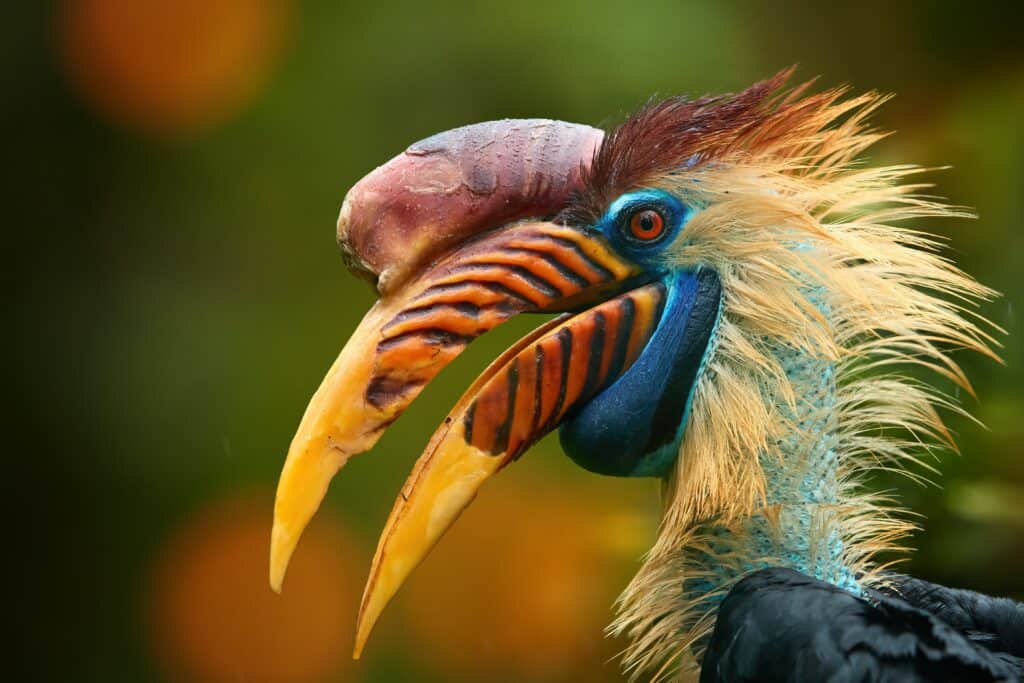
Hornbills have unique, colorful bills.
©Martin Mecnarowski/Shutterstock.com
Hornbills are a family of birds known as Bucerotidae. They are found in tropical and subtropical regions of Africa, Asia, and Melanesia. Hornbills have unique bills that are often large and have various shapes and structures.
One distinctive feature of hornbills is the casque, which is a hollow structure on top of their bills. The casque can vary in size and shape among different hornbill species and is believed to serve various functions, including amplifying their calls and signaling during courtship displays.
Here are some hornbill species known for having large bills:
- Great Hornbill
- Rhinoceros Hornbill
- Helmeted Hornbill
10. Hummingbirds:
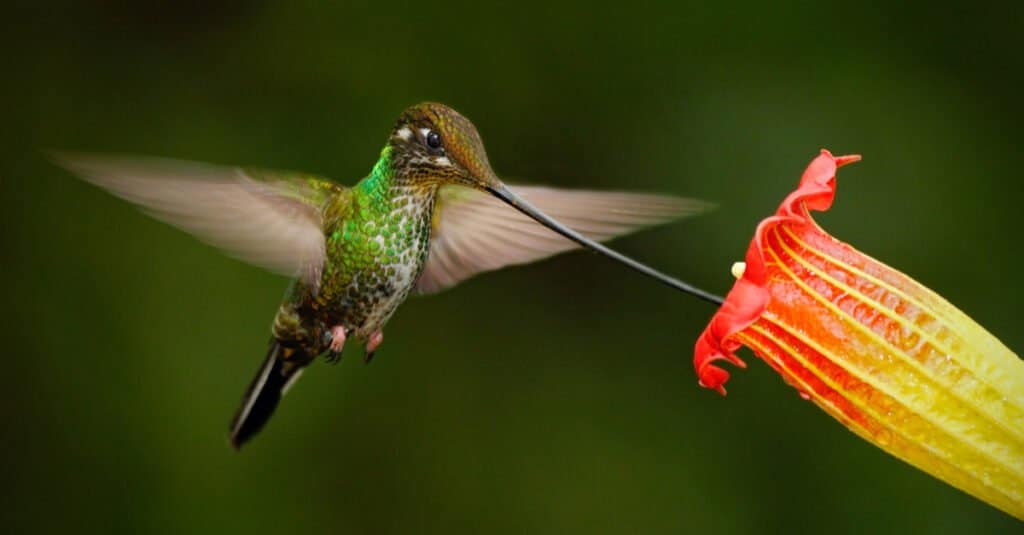
Sword-billed
Hummingbird
©Ondrej Prosicky/Shutterstock.com
Hummingbirds are birds that belong to the family Trochilidae. These tiny wonders have long, slender bills that are adapted for reaching deep into flowers to access nectar. The shape and length of their bills can vary among different species of hummingbirds, allowing them to specialize in feeding from specific types of flowers.
While all hummingbirds have long bills compared to their body size, the Sword-billed Hummingbird (hence its name) has a particularly long and slender bill that makes it stand out from all the rest. Due to the length of its bill, it preens using its feet rather than its bill. It is among the largest species of hummingbirds.
11. Ibises:
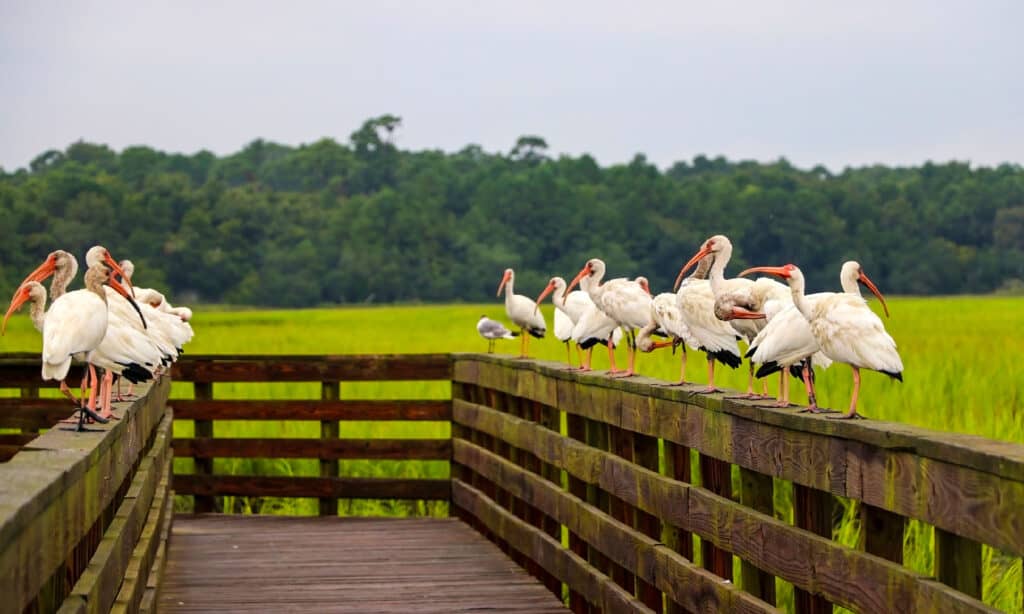
Ibises
©iStock.com/UWMadison
The Ibises is a medium-sized wading bird that belongs to the subfamily Threskiornithinae of the family Threskiornithidae. These incredible birds are known for their distinctive bills, which are long, thin, and often curved. The shape of their bills allows them to probe into mud, water, or other substrates to find food. The bills of ibises are specialized for their feeding habits, which typically involve capturing small aquatic creatures like fish, insects, crustaceans, and mollusks. The bills of ibises are an important tool that helps them survive and thrive in their wetland habitats.
The length and curvature of the bill can vary among different ibis species. Some ibis species known for their distinctive bills include:
- Glossy Ibis
- Scarlet Ibis
- White Ibis
12. Kingfisher:
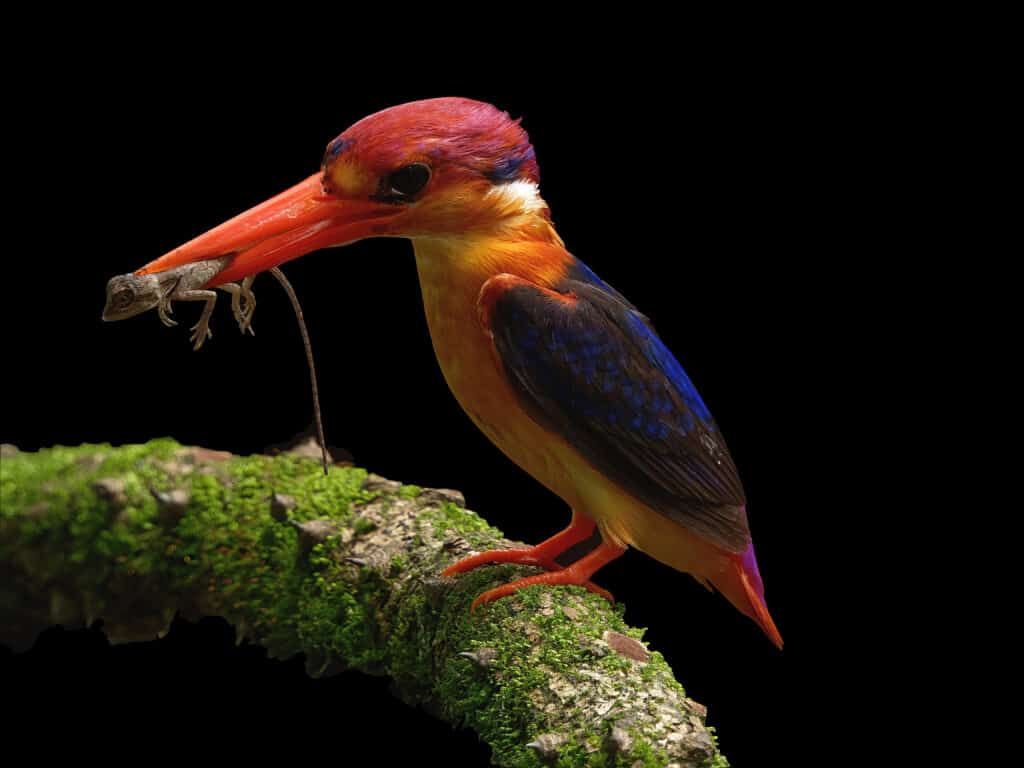
ODKF – Oriental Dwarf
Kingfisher
with a kill
©iStock.com/pushpasen
A kingfisher is a type of bird that belongs to the family Alcedinidae. There are about 90 species of kingfishers found worldwide, with most of them inhabiting tropical regions. The bills of kingfishers are a prominent feature and are known for their various shapes and sizes. The bills of kingfishers are typically long, sharp, and pointed, which is adapted for their feeding habits.
Different species of kingfishers may have variations in bill length and shape, depending on their specific diet and foraging techniques. The bills of kingfishers are used for catching prey, such as fish, insects, crustaceans, and amphibians.
Here is a list of kingfishers known for having relatively longer bills:
- Amazon Kingfisher
- Belted Kingfisher
- Pied Kingfisher
13. Kiwi:
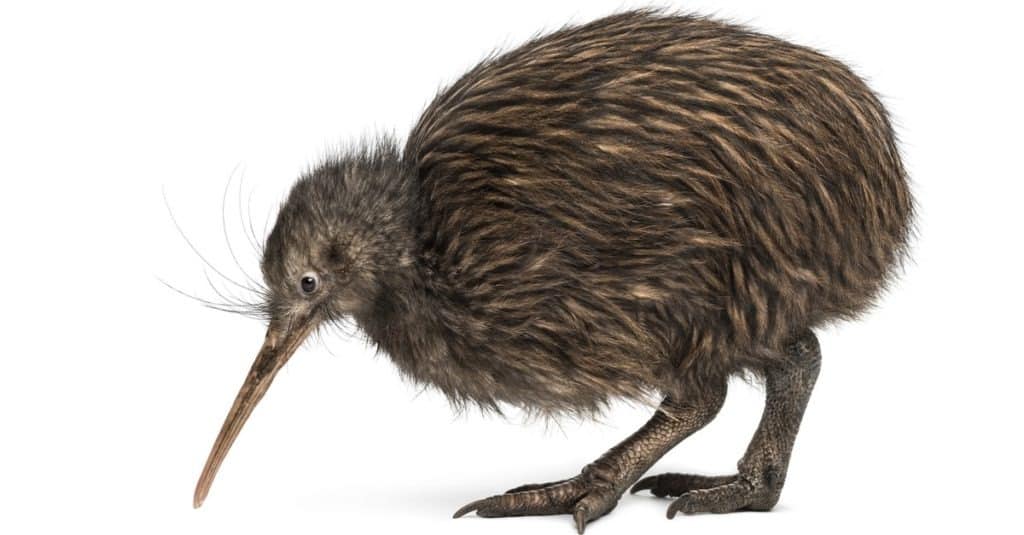
Kiwi Bird
©Eric Isselee/Shutterstock.com
The Kiwi bird is a flightless bird native to New Zealand. Kiwi birds belong to the genus Apteryx and are part of the family Apterygidae. Kiwis are known for their unique characteristics and are considered a national symbol of New Zealand. The bill of a kiwi is a unique feature that sets it apart from other bird species. The bill of a kiwi is long and slender, curving downwards. It is relatively long compared to the size of the bird’s body.
The bill is used for a variety of purposes, including probing the ground for food, such as insects, worms, and other invertebrates. The bill also has sensory pits at the tip, which allow the kiwi to sense prey through vibrations and changes in pressure. Additionally, the bill of a kiwi has a keen sense of smell, which helps the bird locate food.
14. Kookaburra:
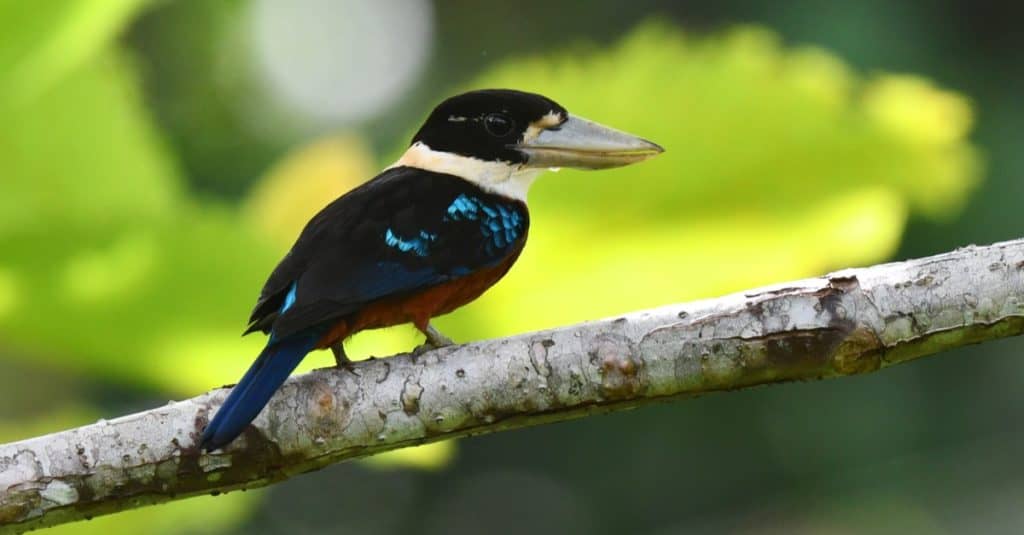
Rufous-bellied
Kookaburra
also known as Gaudichaud’s kookaburra, perched on a branch on the island Waigeo, Indonesia.
©Agami Photo Agency/Shutterstock.com
The Kookaburra is a bird species native to Australia and New Guinea. It belongs to the kingfisher family and is known for its distinctive call, which sounds like human laughter. Kookaburras have a robust, hooked beak that they use for catching and consuming a variety of prey, including small mammals, birds, insects, and reptiles. While the bills of Kookaburras are not particularly long, they are strong and sharp, allowing them to catch and consume their prey effectively.
15. Parrots:
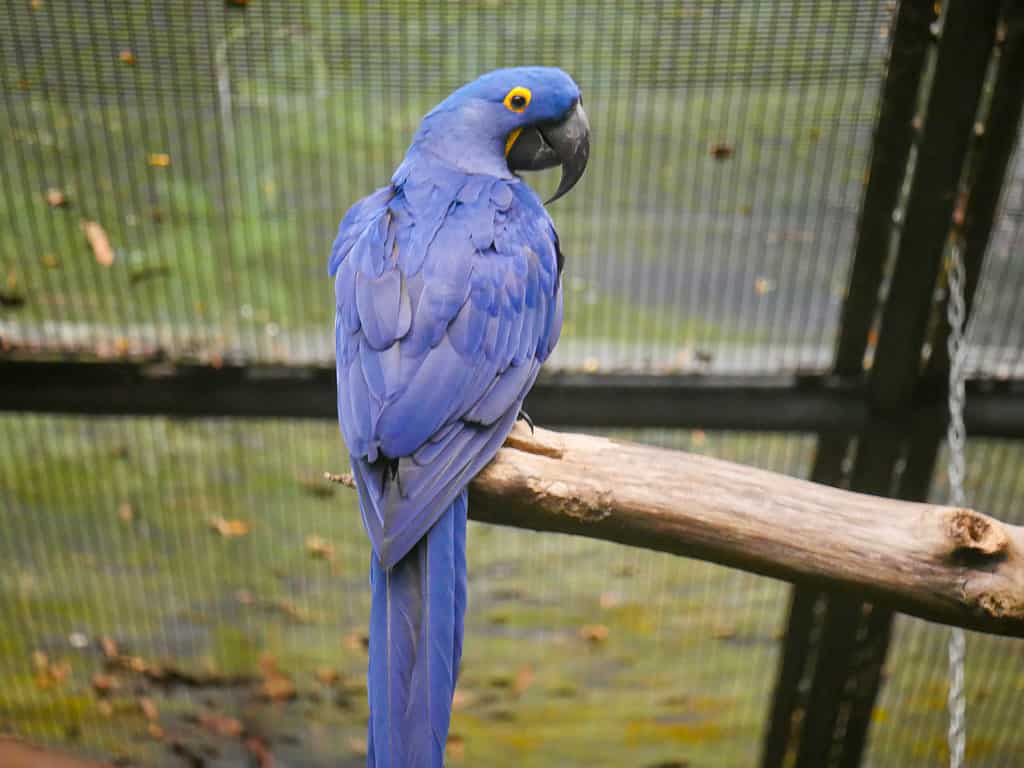
Hyacinth Macaw (Anodorhynchus hyacinthinus), or hyacinthine macaw, is a parrot native to central and eastern South America.
©Azad Jain/iStock via Getty Images
A parrot is a type of bird belonging to the order Psittaciformes, which includes more than 350 species. The bill of a parrot is a specialized structure that is used for a variety of functions, including eating, climbing, and manipulating objects. The bill of a parrot is typically strong and curved, allowing them to crack open nuts and seeds, as well as manipulate and grasp objects. The shape and size of the bill can vary among different species of parrots, depending on their specific feeding habits and adaptations.
Here are some parrot species known for having relatively large bills:
- Hyacinth Macaw
- Kakapo
- Palm Cockatoo
16. Pelicans:
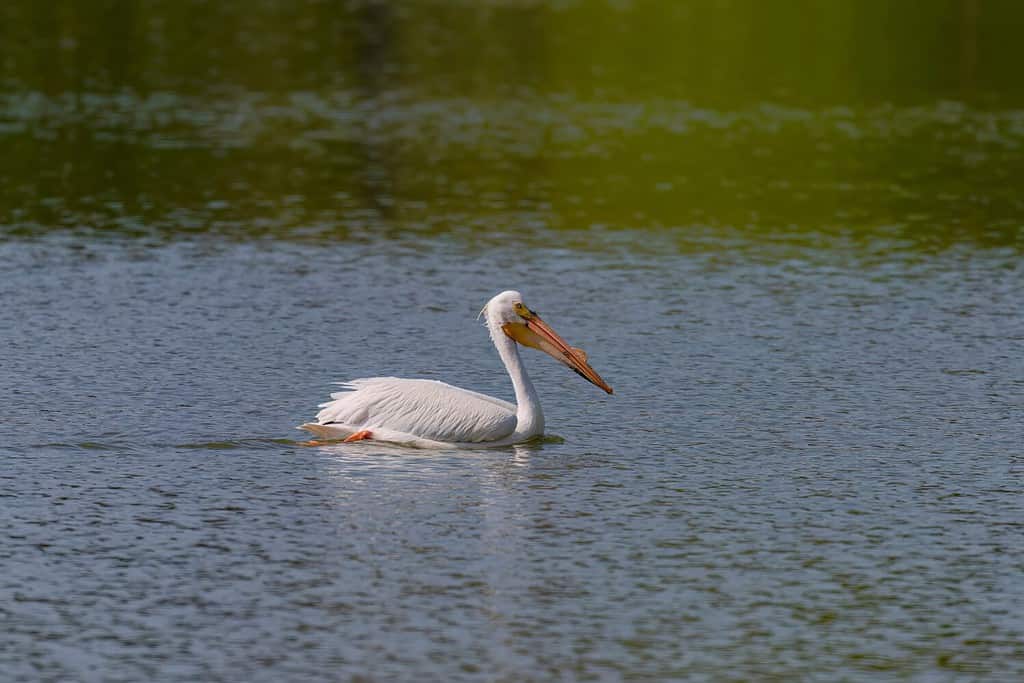
Great White
Pelican
©Karel Bock/Shutterstock.com
A pelican is a type of large water bird belonging to the family Pelecanidae. Pelicans are known for their long, straight bills that are adapted for catching and consuming fish. Their bills are large and have a distinctive pouch that they use to scoop up fish out of water. The bill and pouch of pelicans play a crucial role in their feeding behavior.
Examples of Pelicans with exceptionally large bills include:
- American White Pelican
- Dalmatian Pelican
- Great White Pelican
17. Platypus:

The
Platypus
©John Carnemolla/Shutterstock.com
The platypus is a unique mammal found in Australia. The bill of a platypus is a unique feature that sets it apart from other mammals. The bill is flat and duck-like in appearance, but it is not made of hard material like a bird’s beak. Instead, the bill of a platypus is soft and covered with sensitive skin. The bill is used for various purposes, including foraging for food, sensing prey through electroreception, and navigating underwater. It is a remarkable adaptation that contributes to the platypus’s unique biology.
The bill size of platypuses does not vary significantly among different types or species. The bill of a platypus is generally similar in shape and size across the population.
18. Puffins:
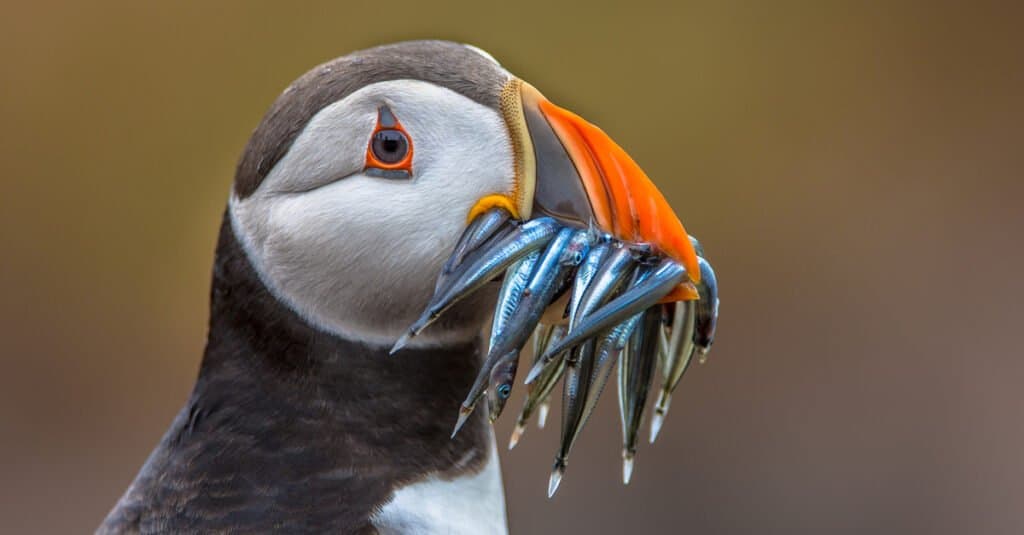
The Atlantic Puffin
©Rudmer Zwerver/Shutterstock.com
A puffin is a seabird that belongs to the family Alcidae. Puffins have large, colorful bills that are shaped like a triangular prism. The bill is bright and vibrant during the breeding season, with different species of puffins having different patterns and colors on their bills. The bill is used for catching and carrying fish, as well as for communication and courtship displays. It is an important tool for the puffin’s survival and plays a crucial role in their feeding and breeding behaviors.
While there is only one species of puffin, the Atlantic Puffin (Fratercula arctica), there are variations in bill size and coloration among individuals.
19. Spoon-billed Sandpiper:
A spoon-billed sandpiper (Calidris pygmaea) is a small wading bird that belongs to the sandpiper family, Scolopacidae. It is known for its unique bill, which has a distinctive spoon-like shape at the tip. The spoon-billed sandpiper breeds in the Arctic regions of Russia and migrates to Southeast Asia for the winter. It is a critically endangered species, with a small population estimated to be around 661-718 individuals. Efforts are being made to conserve and protect this species from extinction.
20. Spoonbills:
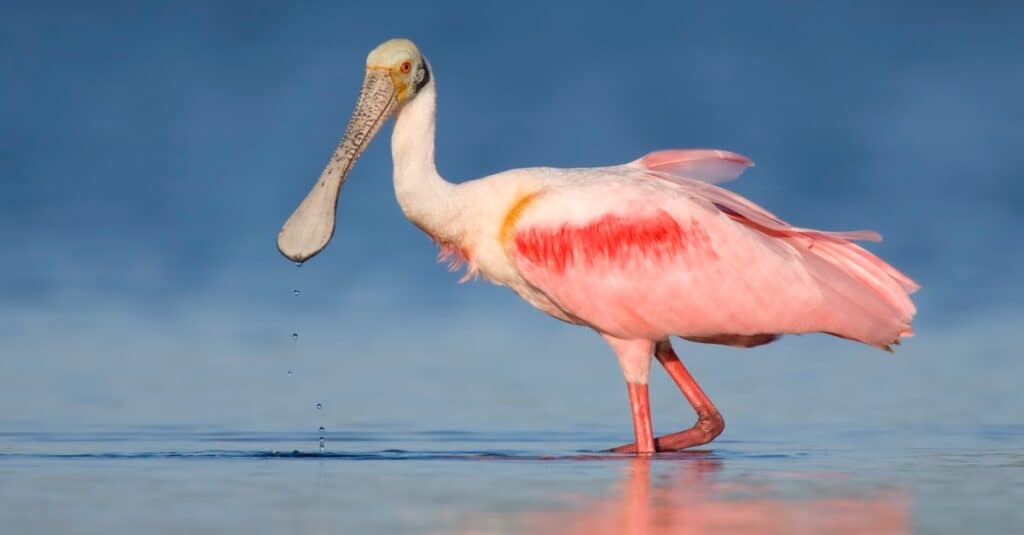
The Roseate Spoonbill has beautiful rose-colored wings.
©iStock.com/Canon_Bob
A spoonbill is a type of large wading bird that belongs to the genus Platalea. The bill of a spoonbill is a distinctive feature that gives them their name. The bill is long and flattened, resembling a spoon at the end. This unique bill shape is adapted for their feeding behavior, allowing them to sweep their bill through the water to catch small aquatic organisms, such as fish and invertebrates. Spoonbills use their bills to filter out food from the water, similar to how a spoon is used to scoop up food.
Here are some species of spoonbills with large bills:
- African Spoonbill
- Eurasian Spoonbill
- Roseate Spoonbill
21. Storks:

Saddle-billed Stork
©Matrishva Vyas/Shutterstock.com
Storks are large, long-legged, long-necked wading birds that belong to the family Ciconiidae. These fascinating birds are known for their large bills, which can vary in shape and size depending on the species. The bills of storks are typically long, straight, and pointed, allowing them to catch and grasp their prey. The size and shape of the bill can also be linked to the stork’s diet. For example, some storks have bills that are specialized for hunting fish in shallow water, while others have bills adapted for feeding on carrion or other prey. Overall, the bill is an important tool for storks, enabling them to feed and survive in their respective habitats.
Examples of storks with particularly large bills include:
- Jabiru Stork
- Marabou Stork
- Saddle-billed Stork
- Shoebill
22. Sunbittern:
Sunbitterns (Eurypyga helias) are bird species native to tropical regions of the Americas. They are the sole member of the family Eurypygidae. Sunbitterns have long, slender bills with a distinctive pattern. They use their bills for catching small fish, amphibians, and insects. There is only one species of sunbittern, which is the Eurypyga helias, and they all have similarly sized bills.
23. Toucans:
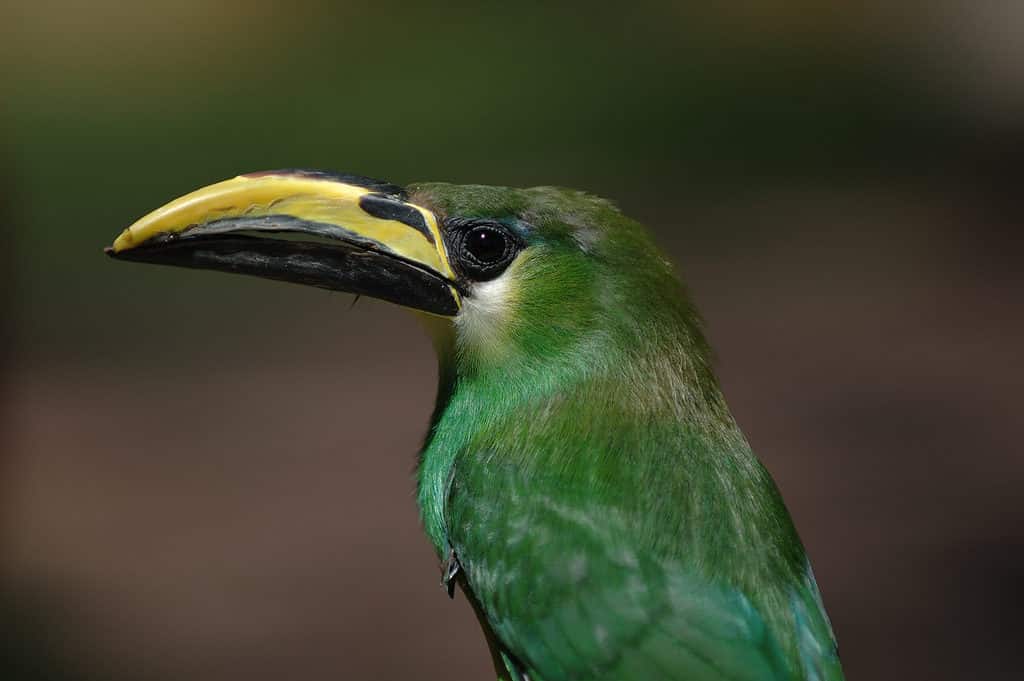
Emerald Toucanet, Aulacorhynchus prasinus – Toucans have big, strong, unique bills that aid in their survival.
©Vlad Turchenko/Shutterstock.com
Toucans are Neotropical birds belonging to the family Ramphastidae. The bill of a toucan is long, curved, and often brightly colored. It is made of a lightweight but strong material that allows the toucan to manipulate and use it for various purposes.
Toucans use their bills for feeding, reaching fruits on branches, gathering food, and even as a means of communication and defense. The bill also plays a role in thermoregulation, helping the toucan to regulate its body temperature. Toucans with particularly large, fleshy beaks include:
- Collared aracari
- Keel-billed Toucan
- Northern emerald-toucanet
- Toco Toucan
The photo featured at the top of this post is © iStock.com/RicInVenice
Thank you for reading! Have some feedback for us? Contact the AZ Animals editorial team.







